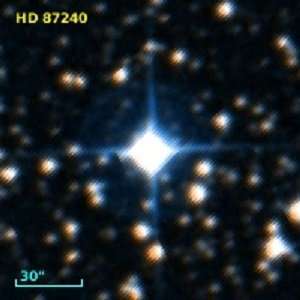October 22, 2018 report
HD 87240 is a chemically peculiar star with an overabundance of heavy elements, study suggests

European astronomers have conducted a chemical study of the star HD 87240, a member of the open cluster NGC 3114. The new research, which determined the abundances of several elements in HD 87240's atmosphere, suggests that the object is a chemically peculiar star showcasing an overabundance of heavy elements. The finding is reported in a paper published October 10 on arXiv.org.
Located some 7,200 light years away in the constellation Carina, NGC 3114 is a sparse, young (about 160 million years old) open cluster. Although the cluster is very difficult to study, due to the high number of field stars from the Galactic disc, it has been a subject of numerous observations since 1963.
Now, a team of astronomers from Paris Observatory and Space Research Institute of Austrian Academy of Sciences, has performed a chemical study of one of NGC 3114's stars, namely HD 87240, which was classified by previous observations as an Ap Si star – a magnetic chemically peculiar star (CP star) with an overabundance of silicon (Si).
For their research, the astronomers used the data collected by European Southern Observatory's (ESO) Very Large Telescope (VLT) in Chile. HD 87240 was observed by VLT's Ultraviolet and Visual Echelle Spectrograph (UVES) in its high-resolution mode on October 26, 2017.
"We have used the code ATLAS9 to compute a model atmosphere for HD 87240 for the effective temperature and surface gravity derived from Stromgren's photometry A grid of synthetic spectra has been computed using SYNSPEC49 and adjusted to the UVES spectrum of HD 87240 to determine the abundances of several chemical elements using the latest critically evaluated atomic data from NIST," the researchers wrote in the paper.
Analysis of UVES data allowed the team to determine chemical abundances for 39 elements in the atmosphere of HD 87240. The astronomers found that this star is significantly overabundant in heavy elements, especially when it comes to platinum (Pt) and mercury (Hg) – about 10,000 times the solar abundances.
Moreover, HD 87240 was found to be unusually rich in silicon (around 10 times the solar abundance) an in the so-called rare-earth elements like cerium (Ce), praseodymium (Pr) and neodymium (Nd) – at a level of at least five times the solar abundances.
HD 87240 also displays solar abundances of carbon, nitrogen and oxygen, as well as scandium (Sc) and vanadium (V). However, the star turns out to be underabundant in light elements such as helium or sulfur.
According to the paper, the derived chemical abundances suggest that HD 87240 should be reclassified as a chemically peculiar late B star with overabundances of silicon, platinum and mercury.
"The derived abundance pattern of HD 87240 departs strongly from the solar composition which definitely shows that HD 87240 is not a superficially normal late B star but is definitely a new CP star. (…) Hence we propose that HD 87240 be reclassified as a Bp SiPtHg star (not as an Ap Si as it currently is)," the researchers concluded.
More information: Elemental abundances of HD 87240, member of the young open cluster NGC 3114, arXiv:1810.04540 [astro-ph.SR] arxiv.org/abs/1810.04540
© 2018 Phys.org


















